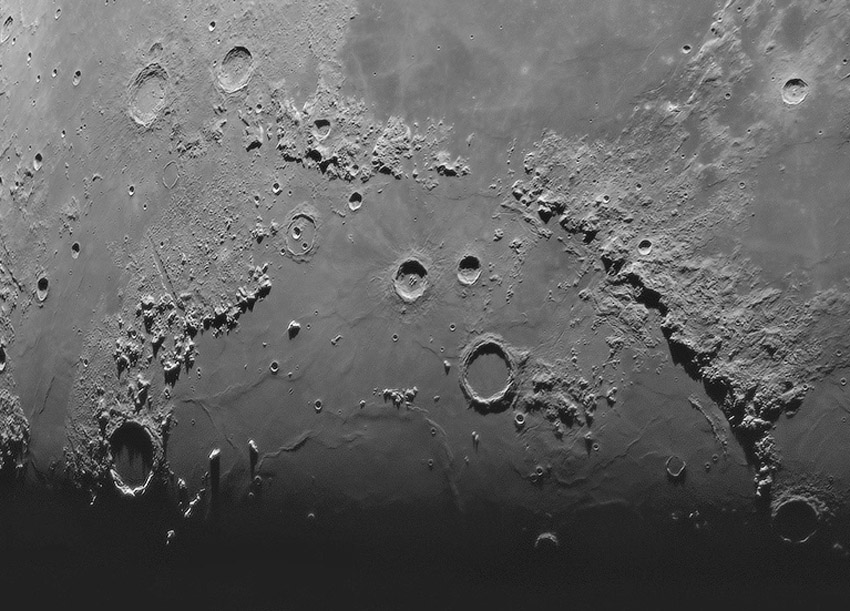Difference between revisions of "April 3, 2010"
| Line 5: | Line 5: | ||
<em>north to the left image by [mailto:pappbandi@gmail.com András Papp] and Jozsef Szehofner, Hungary</em><br /> | <em>north to the left image by [mailto:pappbandi@gmail.com András Papp] and Jozsef Szehofner, Hungary</em><br /> | ||
<br /> | <br /> | ||
| − | If this isn't the most magnificent region of the Moon, what is? The arc of the Apennines, with concentric ridges and peaks on the mare floor, define the Imbrium impact basin. Various craters in different states of preservation and illumination provide exclamation points across the landscape. It is remarkable how different the basin ejecta is from the right to the left sides. The Apennines have towering scarps facing the maria and pasty ejecta with radial texture thinning away from the basin center. The ejecta between Plato and Cassini is completely different. It is less coherent and less spectacular - probably why it doesn't have a name. Some tall mountains face the basin with only scattered hillocks behind them. I had never noticed before the roughly circular patch of taller mountains between Plato and the Alpine Valley. I wonder why they are there? Similarly, I don't remember seeing the shadow-filled short depression near [http://www.lpod.org/archive/LPOD-2004-09-11.htm Pico Beta]. Oops, in checking past LPODs I discovered that it has been imaged [ | + | If this isn't the most magnificent region of the Moon, what is? The arc of the Apennines, with concentric ridges and peaks on the mare floor, define the Imbrium impact basin. Various craters in different states of preservation and illumination provide exclamation points across the landscape. It is remarkable how different the basin ejecta is from the right to the left sides. The Apennines have towering scarps facing the maria and pasty ejecta with radial texture thinning away from the basin center. The ejecta between Plato and Cassini is completely different. It is less coherent and less spectacular - probably why it doesn't have a name. Some tall mountains face the basin with only scattered hillocks behind them. I had never noticed before the roughly circular patch of taller mountains between Plato and the Alpine Valley. I wonder why they are there? Similarly, I don't remember seeing the shadow-filled short depression near [http://www.lpod.org/archive/LPOD-2004-09-11.htm Pico Beta]. Oops, in checking past LPODs I discovered that it has been imaged [[January_18,_2009|before]] under almost identical lighting. But I still don't know what it is, do you?<br /> |
<br /> | <br /> | ||
<em>[mailto:tychocrater@yahoo.com Chuck Wood]</em><br /> | <em>[mailto:tychocrater@yahoo.com Chuck Wood]</em><br /> | ||
| Line 16: | Line 16: | ||
<br /> | <br /> | ||
<hr /> | <hr /> | ||
| − | < | + | <p><b>Yesterday's LPOD:</b> [[April 2, 2010|Barriers]] </p> |
| − | < | + | <p><b>Tomorrow's LPOD:</b> [[April 4, 2010|Dome Heights]] </p> |
| − | + | {{wiki/ArticleFooter}} | |
| − | |||
| − | |||
Revision as of 11:20, 7 February 2015
Half a Basin

north to the left image by András Papp and Jozsef Szehofner, Hungary
If this isn't the most magnificent region of the Moon, what is? The arc of the Apennines, with concentric ridges and peaks on the mare floor, define the Imbrium impact basin. Various craters in different states of preservation and illumination provide exclamation points across the landscape. It is remarkable how different the basin ejecta is from the right to the left sides. The Apennines have towering scarps facing the maria and pasty ejecta with radial texture thinning away from the basin center. The ejecta between Plato and Cassini is completely different. It is less coherent and less spectacular - probably why it doesn't have a name. Some tall mountains face the basin with only scattered hillocks behind them. I had never noticed before the roughly circular patch of taller mountains between Plato and the Alpine Valley. I wonder why they are there? Similarly, I don't remember seeing the shadow-filled short depression near Pico Beta. Oops, in checking past LPODs I discovered that it has been imaged before under almost identical lighting. But I still don't know what it is, do you?
Chuck Wood
Technical Details
March, 23. 2010 between 6:57 - 9:18pm UT. 10" F6,5 home made Newtonian with Orion Optics Ultragrade mirror set + Imaging Source DMK41AF04.AS firewire camera in prime focus. Very short (1/1000s) exposure time and moderate (50%) gain. The full mosaic is composed of 9 separate panels, each the best 256 of more then 8000 frames. Mosaic manually assembled in Photoshop with cosmetic corrections such as levels, curves, sharpening and noise filtering.
Related Links
Rükl plate 11 and others!
Yesterday's LPOD: Barriers
Tomorrow's LPOD: Dome Heights
COMMENTS?
Register, Log in, and join in the comments.



